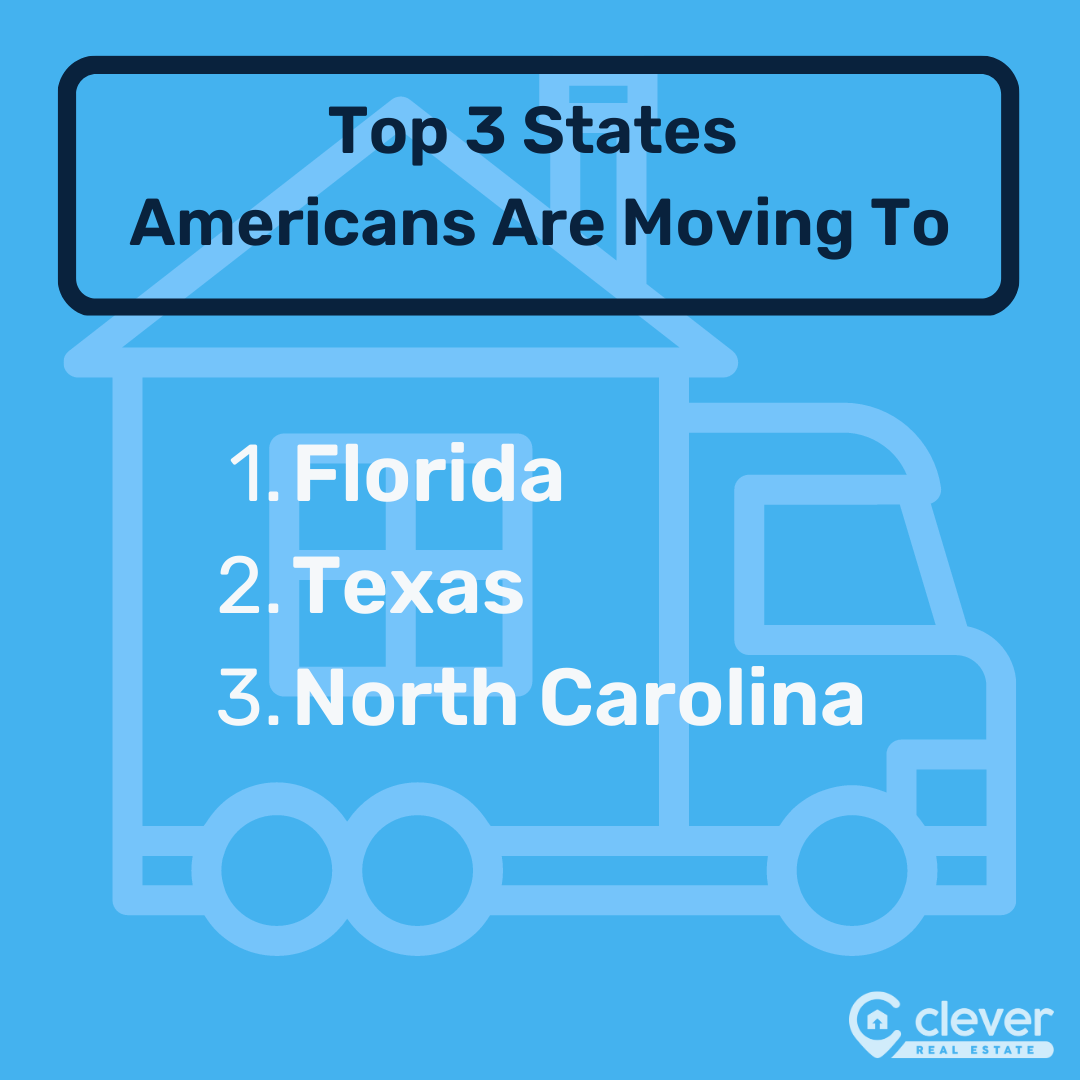|
🚗 Where Do Americans Want to Move? 🚗
California is the most popular state for Americans looking to move, with 27% of respondents choosing it as one of their top five dream states. The most popular city? Los Angeles, with 19% of votes out of the 50 most-populous metros in the country.
|
Where Americans Are Moving | Why Americans Move | Moving Experiences | Lifestyle Changes | The Cost of Moving | FAQs
Despite a challenging economy, the U.S. population continues to increase rapidly because of a growing population of immigrants and a pandemic-induced birth rate bump.[1][2] This has led to a rising cost of living as housing demands outpace inventory during record inflation.
As formerly affordable areas have increased in cost, a significant portion of Americans may choose to move to places where they feel like they can maximize their quality of life. Many Americans are choosing to prioritize other criteria besides cost, such as owning a different kind of home or having access to wide open spaces.
However, moving costs money, particularly for moving services. As a result, 37% of Americans chose just to rent a truck rather than hire professional movers. About 26% do hire movers, while 31% simply opt for assistance with getting boxes to and from a vehicle or pod.
A big question as Americans re-evaluate where they live is: How are people moving in 2023? To answer this question, we surveyed 1,000 Americans on their experience with moving in the past year.
We dug into details about their type of move, their regrets about moving, and how much their move cost (and if the cost surprised them). We also analyzed Census migration data to highlight where people are moving and where people are leaving.
🏘 2023 Moving Trends Statistics 🏘
|
What States Are Americans Moving To?
The most popular state people moved to in 2022 was Florida, while the state people most often moved from was California. Texas was the second-most popular state for Americans on the move, while North Carolina came in third.
While California is a lot of Americans’ dream state, California, New York, and Illinois had the largest number of residents move out of state.
California is a beautiful state with several major cities and a plethora of recreation options. However, it’s also extremely expensive compared to other states. New York is in a similar boat, whereas Illinois’s population losses may be attributed to younger residents leaving the state for job opportunities elsewhere.
States such as Florida, Texas, and North Carolina are still relatively more affordable than many other states, especially outside of major cities. These states are also great options for remote workers or those looking to work in tech.
 |
 |
61% of Americans Moved Fewer than 20 Miles Away
Nearly two-thirds of Americans (61%) moved fewer than 20 miles away from their previous home. This comes at a time when 53% of respondents don’t think it’s a good time to move across the country — likely due to the high cost of cross-country moves.
Moving across the country may also be less appealing to Americans who live in states where moving fewer than 20 miles away means they’ll still end up in another state and with a change of scenery. Think about states such as Rhode Island, Delaware, and Connecticut, for example.
Nonetheless, 1 in 8 Americans (12%) report that they still chose to move more than 100 miles in 2022. The most common moving distance was over 10 miles but fewer than 20 miles.
Almost 1 in 5 Americans Want to Move to Los Angeles
If money were no object, Americans would prefer to move to Los Angeles and California. Migration data, however, shows that more people are moving to cities such as Austin, Raleigh, and Orlando.
Americans’ dream cities are:
- Los Angeles, CA — 19%
- Atlanta, GA — 18%
- Austin, TX — 17%
- Las Vegas, NV — 15%
- Miami, FL — 15%
California Most Popular State for 27% of Americans
Despite more than one-fourth of Americans (27%) stating California is their dream state, it’s experiencing a population decline, with a net loss of 343,230 residents in 2022.
The decline in population is most likely due to California’s high cost of living and climate change woes. When comparing the average monthly rent between California and states where Americans are moving, the differences are glaring:
- California monthly rent: $1,778
- Texas monthly rent: $1,432
- Florida monthly rent: $1,330
Nonetheless, Americans are still dreaming about moving to California more than other states. Here are the top states where Americans wish to move:
- California — 27%
- Florida — 25%
- Hawaii — 22%
- New York — 19%
- Colorado — 17%
24% of Americans Moved to Improve Their Quality of Life
The top reasons Americans moved in 2022 were to improve their quality of life, live in a cheaper area, and get a bigger place.
At 24%, quality of life was the most important factor. However, Americans are also prioritizing better weather, recreational opportunities, and better infrastructure over attributes such as affordability and being closer to loved ones.
- Better quality of life — 24%
- Lower cost of living/home prices — 23%
- Upsizing (i.e., a bigger home) — 22%
- Work flexibility (i.e., working remotely) — 22%
- To live closer to friends/family — 21%
Quality of life can be a little vague, so we asked Americans what exactly constitutes a good quality life. Americans ranked these values in order from most important (No. 1) to least important (No. 10).
Based on our scale, safe neighborhoods (4.68 average rank) and affordability (4.84 average rank) were the most important. Affordability being a top indicator of quality of life is interesting, given that, when asked, Americans consider a “better quality of life” more important than a lower cost of living overall.
75% of Americans Have Regrets About Their Move
Three out of 4 Americans (75%) have regrets about their move, including not liking their new home after all (15%) or wishing they had chosen a bigger home (20%).
Despite their regrets, Americans approached moving with mostly positive emotions.
- Positive emotions: (excited, hopeful, or relieved) — 65%
- Negative emotions: (stressed, anxious, frustrated, or dread) — 59%
The most popular positive emotion was excitement, with 38% of Americans sharing that, overall, they were quite excited about their move. The most common negative emotion was stress at 33%.
A whopping 44% of Americans also reported that they cried at least once during the moving process.
The most common regret Americans had about their moving experience was wishing they had gone with a bigger place (20%). One-fifth of Americans (20%) also shared that after moving away, they missed their original home.
Moving is usually more than just hating where you live, and many Americans are making the painful choice to leave behind a beloved home for work opportunities and more affordable cities.
- I wish I moved to a bigger place — 20%
- I miss my old home — 20%
- I wish I got rid of some belongings instead of moving them — 19%
- It was too much of a hassle — 19%
- It took too long — 18%
Moving Caused 43% of Americans to Fight With Loved Ones
Moving created conflict in personal relationships for 43% of respondents. While it can be shameful to admit, getting into arguments during a move is actually common, given that moving is one of the most stressful times in our lives. With so many things that can go wrong (delays, broken items, lost possessions, etc.), it makes sense that a lot of people will run into conflicts during their move.
Nearly 2 in 3 (62%) still think moving was worth it overall, but a sizable chunk disagrees (38%). Those who fought (42%) were 1.2x times more likely than those who didn’t fight (35%) to say moving was not worth it after all.
28% of Americans Regret Not Hiring Movers
Besides passing up the large home of their dreams and missing their old abode, Americans also regret their moving-related decisions. More than 1 in 4 (28%) regret not hiring a mover or moving company.
Movers can be expensive, so many people forego them entirely. However, the money saved by going it alone doesn’t always outweigh the soreness and stress from moving oneself.
25% of Americans Left Major Cities for the Suburbs
One-fourth of Americans (25%) moved from cities to suburbs, and 31% of rural residents moved to suburban areas.
The most common choice for Americans seemed to be the suburbs (39%) because they offer a middle ground between crowded, bustling urban areas and the “country,” which can be a bit too quiet for those who enjoy socializing and nightlife.
Suburbia also tends to be cheaper than living in cities proper. For many, the savings on having a house in the suburbs outweighs the convenience of living closer to downtown.
Despite where they actually moved, Americans do prefer to live in cities over suburbs and rural areas (40%). Only 29% of Americans stated they would choose to live in the suburbs, and 31% said they’d choose to live in a rural town if money were no object.
37% of Americans Who Moved Remained Renters
More than one-third of Americans (37%) who moved remained renters. This tracks with the 51% of Americans who shared that they don’t think it’s a good time to buy a home.
With record inflation, more people are choosing to stay with family and forego rent or a mortgage: 22% report that they live with family or friends without paying any rent at all. Moving into a place without any rent obligations seems to have been a major factor for those who relocated last year.
Most Americans moved into apartments last year (33%), followed by 31% who moved into single-family homes. The least popular choice was townhomes (17%), falling slightly below by condominiums (19%).
The majority of those who moved last year left other single-family homes (32%), indicating that those who were already living in standalone houses opted to move into a different one, perhaps in a different city or more affordable neighborhood. The second-most common style of home that people left was apartments, with 31% of respondents reporting that as their original residence.
50% of Boomers Upsized, Compared to 32% of Millennials
Older Americans and younger Americans are making different choices when it comes to housing. Half of boomers (50%) actually upsized, compared to just 32% of millennials. Only 31% of boomers downsized, compared to 40% of millennials who had to.
This tracks with income and wealth reports that illustrate the income gap between millennials and their parents (typically, boomers). This also negates the often-reported trend that as people retire, they tend to downsize. Boomers are not like the Silent Generation in this regard.
Across generations, three-bedroom residences were the most popular choice for new homes (28%), but they were also the most common residences that respondents moved out (28%). The second-most popular choice was two-bedroom homes, which tend to be cheaper than three-bedroom homes but offer additional space and privacy that people cannot get in a studio or one-bedroom residence.
The size of the residence you moved into:
- Studio — 11%
- 1 bedroom — 14%
- 2 bedrooms — 23%
- 3 bedrooms — 28%
- 4 bedrooms — 15%
- 5+ bedrooms — 10%
The size of the residence you moved out of:
- Studio — 10%
- 1 bedroom — 17%
- 2 bedrooms — 23%
- 3 bedrooms — 28%
- 4 bedrooms — 13%
- 5+ bedrooms — 10%
Nearly Half of Americans Hired Movers and Still Had Items Break
Almost half of Americans (49%) who hired moving companies said items broke during the move. This comes at a time when 49% don’t think moving companies are honest.
Although many movers try to assure clients that they are adept at securely transporting their belongings to and fro, sometimes inadequate packing by the clients can lead to items breaking. Paying extra to have the movers pack up one’s home often includes more coverage for damages should anything break during transport.
On the flip side, a perk of packing your own items is that you know just how fragile they are, which can help you pack them most effectively. While 49% of those who hired moving services reported broken items, only 34% of those who did not hire movers report the same. Overall, 43% of respondents reported broken items.
Most Americans expect at least one thing to go wrong during their move, so 47% of respondents purchased moving insurance. Moving insurance typically covers damage to one’s belongings, as well as complete loss.
Despite the possibility of broken items, most people choose to work with movers because it’s easier: 43% of Americans stated that working with a mover is easier than going it alone.
Forty percent also reported that hiring a mover saved them time, and 36% stated that working with a mover is actually more cost-effective than moving on one’s own.
- It’s easier — 43%
- It’s time-saving — 40%
- It’s cost-effective — 36%
- I didn’t want to/could not do it myself — 27%
- I didn’t want to inconvenience friends or family — 25%
- My employer paid for it — 22%
Moving companies offer more than just transportation services. They typically also provide additional services that allow customers to decide just how much help they need.
The most common add-on service that Americans purchase is a rental truck(37%). The second-most popular services are packing supplies (31%) and labor (31%), which includes moving items from the home to the client’s truck or pod.
Other popular add-ons include:
- Truck rental — 37%
- Packing supplies — 31%
- Labor — 31%
- Storage — 28%
- Furniture assembly and disassembly — 26%
Of Americans who moved solo — without a partner, friends, or family — 22% still opted to hire moving companies for labor assistance, citing saving time as the primary reason (36%). Interestingly, a higher number of Americans who didn’t move alone also reported saving time as the primary reason for hiring labor assistance (41%).
Labor assistance may be more important to families or groups of friends moving together simply because multiperson homes typically have more possessions to move. Another important factor to keep in mind is that the more people who are moving together, the harder it is to coordinate the move. That is where movers come in handy.
The Cost of Moving Surprised 43% of Americans
Forty-three of Americans said the cost of moving surprised them. A majority of Americans spent less than $,2000 on their moves (54%), while 46% spent more than $2,000. In particular, 7% spent $5,000 or more. Typically, the longer the move, the more it will cost as moving companies charge based on the distance and time needed to move.
The surprise may come from the costs associated with using moving services: 46% of those who hired moving services were surprised by moving costs, whereas only 38% of those who didn’t use moving services reported being surprised.
Of those who hired moving services, 60% budgeted their move correctly. In contrast, 68% of those who didn’t hire moving services thought they budgeted correctly. This indicates that Americans may be underestimating how expensive moving services are.
What Americans save in money, they may be paying in stress. Only 56% of Americans who purchased moving services reported that the moving process was stressful, compared to 68% of Americans who didn’t utilize any moving services.
About 1 in 3 Americans (32%) who didn’t hire moving services said moving companies are too expensive, and 59% of Americans overall said moving companies tend to overcharge. Moving companies should take note because the high cost of movers is one of the most common reasons people move alone.
Sixty percent of Americans who used moving services spent more than $2,000 on their move, whereas only 46% of all respondents reported spending that much. Americans who made long-distance moves paid the price as well, with 60% of them spending $2,000 or more.
37% of Americans Believe They Did Not Budget Correctly for Their Move
More than 1 in 3 Americans Americans (37%) believe they did not budget correctly for their move. Underestimating is the most common budgeting mistake, with 17% of Americans reporting that their move was ultimately too expensive. Getting locked-in quotes from movers ahead of time can improve the accuracy of moving budgets.
Many Americans research moving companies’ rates ahead of time. More than one-fourth of Americans (26%) named price quotes as a top factor for choosing a moving company, and 24% said discounts and deals enticed them.
Despite getting a quote, 40% were charged something different from what they were quoted. This can happen because of a variety of factors, such as travel delays or having more boxes or furniture than was reported.
Some moving companies offer binding estimates, which means the client will pay what was agreed upon, regardless of any changes. However, nonbinding estimates are much more common, so Americans looking to hire movers should be as accurate as possible in their assessment of what needs to be moved.
81% of Americans Tip Their Movers
Good news for movers: 81% of Americans reported tipping their movers once the job was completed. About 1 in 4 Americans (22%) tipped 5% or less, while 1 in 8 Americans (13%) reported tipping 20% or more for moving services.
With long-distance moves sometimes totaling over $1,000, even a 5% tip adds up. Americans budgeting for their move should also account for additional costs associated with tips.
Methodology
The proprietary data featured in this study comes from an online survey commissioned by Home Bay. One thousand people were surveyed Dec. 29, 2022. Respondents answered up to 21 questions related to their recent experience moving within the past year. U.S. Census Bureau Migration Data is also cited in the discussion of population increases around the country.
About Home Bay
Where your real estate voyage begins. Since 2014, Home Bay has helped thousands of readers confidently sail through their next home sale or purchase. In 2021, Home Bay was acquired by Clever Real Estate, a free agent-matching service that has helped consumers save more than $82 million on real estate fees. Research by Home Bay’s Data Center has been cited by The New York Times, CNBC, MarketWatch, NPR, Apartment Therapy, Yahoo Finance, Black Enterprise, and more.
More Research from Home Bay
Articles You Might Like
Frequently Asked Questions
What state do people want to move to?
California is the most popular state that Americans want to move to (27%). Runner-ups are Florida (25%), Hawaii (22%), New York (19%), and Colorado (17%). Find out more about the most popular states.
Where are people moving to?
Based on migration data from the U.S. Census Bureau, Americans are moving to Austin, Texas; Raleigh, North Carolina; Orlando, Florida; Dallas, Texas; and Phoenix, Arizona. The most moved-to cities are based on percentage increases in population since 2010. Learn more about U.S. moving trends.
What is the next up-and-coming city?
Los Angeles, Atlanta, Austin, Las Vegas, and Miami are still the hottest tickets in the country. This is based on survey data from 1,000 Americans who said they’d move to these cities first if money were no object. Although these are already major metros, they’re all experiencing growth in their populations.
How much money should I budget for moving?
The majority of Americans (61%) spend over $1,000 on moving, and 46% spend over $2,000. It’s safe to suggest saving at least $2,000 for your move, especially Learn more about U.S. moving trends.






